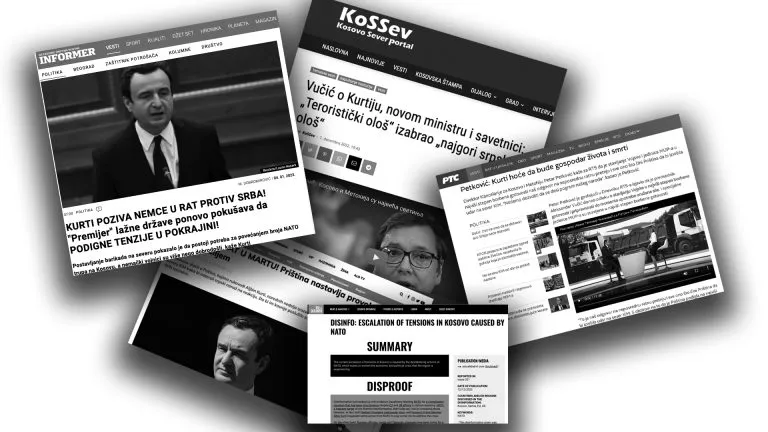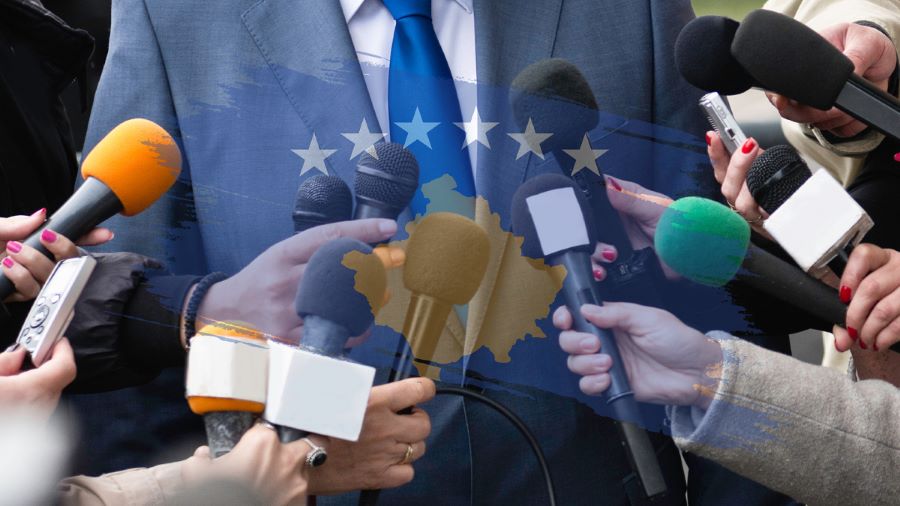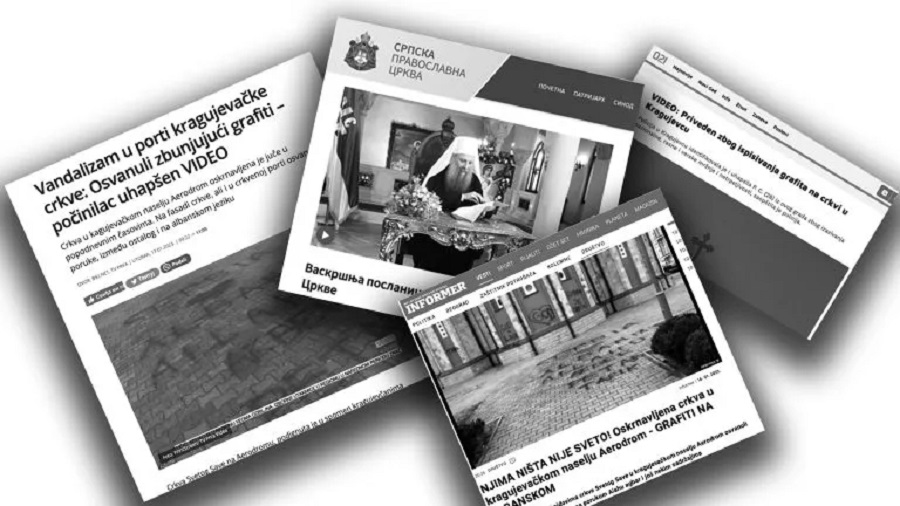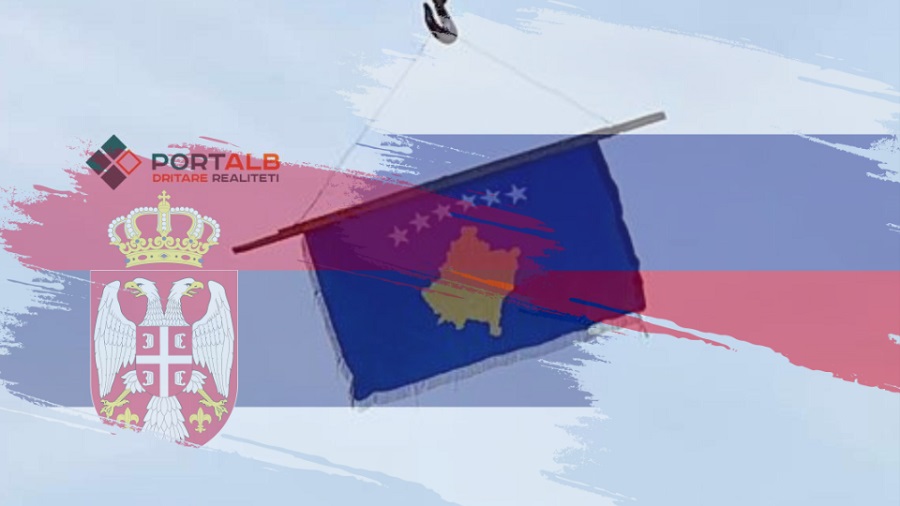This article by Ardit Kika was originally produced for and published by Kosovo 2.0 as part of Western Balkans Anti-Disinformation Hub project. It has been republished here with permission.
Serbia, Russia and China are the main disseminators of disinformation in Kosovo and about Kosovo. Serbian-speaking audiences are the main targets of disinformation from Serbian and Russian media outlets, while Chinese media outlets more often focus on Albanian-speaking audiences.
On November 2, 2022, a video from a private care home for the elderly in Peja appeared online. The video showed a young nurse beating an elderly woman, slapping her and pushing her against the wall. The video showed that as the nurse taunted, slapped and humiliated the old woman she was supposed to be caring for, her colleagues were laughing. The old woman cried and begged them to stop.
The video of the mistreatment spread widely on social media and became the news of the week in Kosovo and beyond.
Some media outlets in Serbia picked up the story and falsely reported that the elderly Albanian woman was Serbian and that the attacker was Albanian, transforming an act of elder abuse into an inter-ethnic incident.
This is just one of many instances when the Serbian media has invented an ethnic angle in news stories, either to incite tensions or as a result of republishing unverified information. Considering the often tense relations between Kosovo and Serbia, this happens frequently.
A central narrative that this type of disinformation tries to create is that Kosovo’s Serbs live in unbearable conditions due to Albanians and Kosovar state authorities.
Serbia is not alone in this. The pro-government media of Russia and China, alongside Serbia, are the main disseminators of disinformation in Kosovo and about Kosovo. Serbian-speaking audiences are the main targets of disinformation from Serbian and Russian media outlets, while Chinese media outlets more often focus on Albanian-speaking audiences.
These countries’ disinformation campaigns in Kosovo are part of a broader global information disorder. Disinformation — increasingly defined as “a weapon of intervention” by “malign external forces” — is increasingly being used in the digital information space to undermine democracies around the world or to cause political or social disorder.
Although the purposes of Serbia’s and Russia’s disinformation campaigns in Kosovo differ from China’s, all three demonstrate how easily these campaigns have broken into the Kosovo media sphere.
Multi-dimensional disinformation from Serbia
Since 2011, a dialogue mediated by the European Union has been taking place between Kosovo and Serbia with the aim of normalizing relations. Although more than 30 agreements have emerged from this dialogue, they largely remain unimplemented and relations between Kosovo and Serbia remain tense.
Incendiary reports with baseless assertions, especially about Kosovo Serbs, appear frequently in the Serbian media. The source of this misinformation is often Serbian government officials.
This type of misinformation escalates when there are developments in the north of Kosovo. Political disagreements between Kosovo and Serbia — caused by Kosovo’s efforts to assert its statehood and Serbia’s efforts to maintain its power in four Serb-majority municipalities in northern Kosovo — have often taken the form of tensions.
In June 2022, the government of Kosovo issued a decision to gradually ban Serbian license plates issued for cities in Kosovo. Protesters barricaded the two roads that connect the north of Kosovo with Serbia. In November, Serbs resigned en masse from the public institutions of Kosovo, including police officers, prosecutors, judges, mayors and deputies of Srpska Lista in the Kosovar Assembly. Barricades then went up and remained for weeks and Kosovar police officers on the scene reported being shot at by unknown individuals on multiple occasions.
Around this time the head of the Serbian government’s Office for Kosovo and Metohija, Petar Petković, publicly stated that the tensions in the north represented the government of Kosovo preparing for bloodshed against Serbs.
“We will not allow a pogrom against our people,” he said at the end of last year on Radio Television of Serbia (RTS).

Hibrid.info, an online fact-checking platform, has categorized hundreds of public statements and news reports in the Serbian media as disinformation, unverified and conspiratorial. Since 2020, the platform has been monitoring the penetration of disinformation in Kosovo and the actors behind it.
“The Office for Kosovo in the government of Serbia with its director Petar Petković leads things. From time to time it is also the President Aleksandar Vučić,” said Shkëlzen Osmani, head of Hibrid.info. When the situation in the north of Kosovo becomes tense, Osmani said, the most common disinformation he sees is a narrative that Kosovo’s institutions are planning to expel Serbs from the country.
During the last year, baseless official statements and subsequent reports in the Serbian-language media asserted that Kosovo’s institutions have a list of 230 Serbs they intend to arrest. Other narratives have been that Kosovar Prime Minister Albin Kurti wanted to start a war with Serbia “in March 2022” and that Kurti has requested German troops join KFOR, the NATO military mission in Kosovo, in order to fight Serbs in the north.
President Vučić is known for using hate speech against specific individuals in public.
On December 1, 2022, he called Prime Minister Kurti “terrorist scum.” Vučić was lashing out after Kurti appointed Nenad Rašić, who opposes Vučić, as Minister for Communities and Returns. He also referred to Rašić and an appointment of his, Rada Trajković, as terrorist scum in an interview with the Serbian television channel Pink. He then shared the interview on his YouTube channel.
Disinformation from Serbia largely targets Kosovo Serbs
According to Abit Hoxha, media researcher at Adger University in Norway, this is an attempt to normalize the language of hatred against Kosovo.
“The use of hate speech in combination with the accusations that the Serbian state makes about the leadership of Kosovo, such as against Kurti, but also Rašić and Trajković, aims to create a negative perception of these personalities,” said Hoxha.

Disinformation from Serbia also targets Kosovo Serbs. Largely consuming media directly from Serbia or which is influenced by Serbian government preferences, their media environment is dramatically different from Kosovar Albanians.
Tatjana Lazarević, editor of the Serbian-language Kosovo Sever portal (Kossev) said that Serbs have been the main target of disinformation during the tensions in the north in 2022.
Citizens were exposed to a propaganda war between the political and institutional structures of Serbia and Kosovo, which was spread through the media and social networks during successive crises in the north throughout 2022. Those who were most affected, the citizens in the north, were most exposed, said Lazarević.
The influence that this disinformation has among the Serbian-speaking audience in Kosovo is amplified by some of the local Serbian-language media in Kosovo, most of which, according to Lazarević, support the government of Serbia unconditionally. As she wrote in an opinion piece, independent Serbian-language media outlets in Kosovo are small and have a limited market.
When the disinformation surrounding the event at the retirement home in Peja started spreading, one of the more prominent cases in the last year, the Hibrid.info platform went into action.
The online Serbian-language media outlet Alo.rs reported on the case with the title “VIOLENCE IN A HOME FOR THE ELDERLY – Albanian nurse beats and mistreats Serbian elderly woman (VIDEO).” The subtitle was “Incidents in homes for the elderly are increasing.”
The day that the disinformation about the elderly woman being Serbian was spread, Hibrid.info immediately alerted its peer verification organizations in Serbia, Montenegro and Bosnia and Herzegovina.
Alo.rs then added a revised version of the text with the note: “In the original text it was said that the elderly woman was of Serbian nationality, which after the analysis of the fact-checking portals, raskrinkavanje.me and raskrinkavanje.rs, turned out to be fake news. We have changed the title and now it contains the correct information.”
The false reports about the elderly victim being Serbian appeared on Spanish media outlets only a day after the attacks
The disinformation campaigns have targets outside the Serbian-language media space. The false reports about the elderly victim being Serbian appeared on Spanish media outlets Telecico.es and Marca.com only a day after the attack. In order to get the Spanish outlets to retract their articles, Osmani sent fact-checking data to Spanish fact-checking organizations Maldita and Neutral. Among other things, he sent interviews that the elderly victim’s family gave to Kosovar media and personal data about the victim provided by the Ministry of Internal Affairs of Kosovo. Osmani exchanged around 30 emails in one week with the Spanish fact-checkers until they were satisfied.
We had more difficulty with Spanish fact-checkers because they do not know the context of Kosovo or only knew a little. They don’t know that a person with the victim’s last name must necessarily be Albanian, said Osmani.
Regardless of the labor, he is relieved that the article has been corrected.
The effect is visible because those media outlets no longer have [the disinformation] and as a result they either [have removed it] or have corrected it. Now when someone searches online for certain issues about Kosovo and suddenly comes across such an article, it is no longer misinforming, but informative, said Osmani.
Disinformation and the Serbian Orthodox Church

An institution that is often the subject of disinformation from the Serbian media is the Serbian Orthodox Church and Serb religious sites in Kosovo. The Serbian Orthodox Church (SOC) is particularly important in the media because it plays an active political role in the dynamics and power struggles between Kosovo and Serbia.
The SOC has significant political influence in Serbia and among Serbs, and its representatives are vocal about continuing to consider Kosovo as part of Serbia. For years, their representatives in Kosovo have refused to be in direct dialogue with the government of Kosovo as a result of the non-implementation of a Kosovo Constitutional Court verdict calling for the return of lands owned by the SOC’s Visoki Dečani Monastery.
Even after the agreement between Kosovo and Serbia to give the SOC special status and to provide for the protection of Serbian religious and cultural heritage sites in Kosovo in accordance with European models, the Church did not change its stance towards Kosovo. In a 2023 Easter speech in April, Church Patriarch Porfirije said that “the alienation of Kosovo and Metohija by the state of Serbia, directly or indirectly, de facto or de jure, is unacceptable.”
In recent years, there have been disinformation and conspiratorial reports in Serbian media about the vandalization of Serbian religious sites and about the possible extinction of the SOC.
Disseminators of disinformation from Serbia take advantage of a wide variety of news developments to spread false news about Kosovo
In January 2023, Serbian media outlets such as B92, 21.rs, Informer and Television Prva, reported on Albanian language graffiti painted on the Sveti Sava Church in Kragujevac, Serbia. The reporting claimed that some of the graffiti read “Serbia is the heart of Albania.” The news turned out to be false, as there was no graffiti in Albanian on the wall of the Sveti Sava church.
The graffiti was in English and Serbian with the exception of “Allahu akber” which is similar to “Allahu Akbar” (“God is great” in Arabic).
B92 did not change their false subtitle, though 21.rs revised their post and indicated that there was no graffiti in Albanian. The news was revised in an updated text after the Serbian fact-checking platform, FakeNews Tragač confirmed that the graffiti was not written in Albanian.
There have also been articles published suggesting that there is a secret plan by Kosovo’s institutions for the erasure of the SOC. This year, on January 25, the government approved a draft law on religious communities that provides the criteria and deadlines for the registration of religious communities in Kosovo.
Despite this, the Serbian portal Alo.rs republished an article from Gazeta Express (which was itself a copy of a Radio Free Europe article) titled “What does the new Draft Law for Religious Freedom in Kosovo entail?” but changed the title to “Kurti’s monstrous plan is published: Albanians want to erase the Serbian Orthodox Church! The draft law that is being prepared in Prishtina!” In no part of the original article is it stated or implied that the draft law would bring about the erasure of the SOC, as the Alo.rs title states.
According to Osmani from Hibrid.info, the distribution of such news about the SOC is not done on a regular basis, but from time to time takes place in pro-government Serbian media.
Nevertheless, disseminators of disinformation from Serbia take advantage of a wide variety of news developments to spread false news about Kosovo.

Russia: Serbia’s ally in disinformation spreading
Russia has engaged in an ongoing effort to produce and spread disinformation that could increase tensions around the world. This includes using social media and online forums to spread false narratives and propaganda and promoting conspiracy theories. Russia’s disinformation campaigns have been linked to several major world events such as the 2016 U.S. election and the war in Syria.
In the Balkans, Russian disinformation campaigns mostly pass through Serbia, which has the closest ties to Russia in the region. Russia’s attempt to influence the information space in the Balkans is widely seen as an attempt to put a wedge between these countries and Euro-Atlantic institutions and to otherwise cause disorder.
Kosovo, whose independence is opposed by Russia, is no exception. Serbia claims historic friendship with Russia and is the only country in Europe to have vocally opposed sanctions on Russia after the invasion of Ukraine in 2022. These ties are clear in the way the Russian Ministry of Foreign Affairs talks about Serbia and Kosovo.
For example, the earliest press release from the Russian Federation available on their English-language website dates back to September 2001. The press release is a solemn statement grieving for the victims of the September 11 terrorist attacks of the Twin Towers in New York City in which 2,996 people died. But the statement also falsely suggests that Albanians were committing similar terrorist acts in Kosovo and Macedonia.
The KIPRED Director Lulzim Peci said that Serbia and Russia have similar narratives regarding Kosovo.
According to Peci, Russia has four main narratives in their disinformation campaign: presenting Kosovo’s independent as illegal; presenting Kosovo as a criminal entity that oppresses the Serb community and the SOC; manipulating historical narratives about the conflicts in the former Yugoslavia by inflating the number of Serb casualties; and undermining the historical role of the U.S. and EU countries in Kosovo’s state building.
According to Peci, in the context of the war in Ukraine, violent conflict in Kosovo would suit Russia.
Russia does not aim to protect the Serbs in Kosovo, but to destabilize Kosovo and start a conflict, which would serve them,” said Peci. “It is a distraction because then the West would have to work on two fronts… Russia wants to see conflict and normally nurtures it and on the other hand it presents the West as incapable of managing the situation in Kosovo.
According to a report by the Democracy Plus organization in Kosovo, the local Serb community is the most vulnerable to disinformation, due to the positive perception of Russia and China. The report concludes that: “Kosovo Serb citizens view Western powers less favorably and the majority would not vote for joining either the EU or NATO. Differing from Kosovo Albanians, Kosovo Serbs’ opinions about Russia and China are positive.”
After Russia’s full-scale invasion of Ukraine in February 2022 and growing concern about pro-war Russian propaganda, Kosovo, like EU member states, banned pro-Kremlin Russian media last year. “Sputnik and Russia Today are essential and instrumental in bringing forward the military aggression against Ukraine through disinformation, information manipulation and distortion of facts,” the European Commission argued at the time.
Initially, the Independent Media Commission (IMC) in Kosovo ordered all distribution operators to stop broadcasting channels of Russian origin such as Russia Today, Russia 24, Planeta RTR and Russia Today Doc. After about a month, the Regulatory Authority of Electronic and Postal Communications (RAEPC) instructed internet operators to block the domains of the portals rt.com, francais.rt.com, sputniknews.com, sputniknewslv.com, sputniknews.gr, sputniknews.cn.
But, according to Osmani, making it difficult for readers in Kosovo to access the propaganda and disinformation media of external powers does not have a major effect. Anyone who has internet access can find ways to access restricted pages such as by using a Virtual Private Network (VPN), which enables an encrypted online connection regardless of location.
The RAEPC did not take additional actions after Russia Today Balkan opened the new portals rt.rs and Sputnikportal.rs.
Sputnik and Russia Today have never had an Albanian language portal or television station.
Since the invasion of Ukraine, the Russian media have increased their output in the Serbian language. Serbia has not imposed sanctions on any Russian media outlets.
“We opened RT in the Balkans. Because Kosovo is Serbia,” Margarita Simonyan, editor-in-chief of Russia Today, wrote on her Twitter account in November 2022, when the new portal was opened in Serbia.

In addition to Serbian-speaking audiences, the Russian media have also targeted audiences of more widely spoken languages with disinformation, such as Spanish and Arabic. For example, during winter tensions in the north of Kosovo, reporting from Russia Today in English and Spanish, supported by political commentators in the studio, blamed NATO and the Kosovo government for igniting the tensions.
In December 2022, around the time of the removal of barricades in the north of Kosovo, Russia Today wrote about the prospects of a repetition of Operation Storm of 1995, during which the Croatian military recaptured Serb-occupied parts of the country and, according to the Helsinki Committee, killed 410 Serb civilians and expelled an estimated 200,000 Croatian Serbs from their homes.
Russian media, even when tensions are low in the north of Kosovo, have asserted without evidence that the role of NATO forces and Western countries is to cause crises in Kosovo and incite violence against the Serb community. NATO countries and the EU have consistently called for the reduction of tensions and have engaged Kosovo and Serbia in a dialogue facilitated by the EU to address the unresolved issues between them.
In December 2022, Kosovo applied for EU membership. In response, five Arabic-language Russian portals misinformed their readers about the legality of Kosovo’s application. An EU project, “EU vs. DISINFO,” has identified news articles that falsely claim that the submission of Kosovo’s application is contrary to the ban on application to international organizations, which was agreed on as part of the Washington Agreement between Kosovo and Serbia at the White House in September 2020.
One of the points of the Washington Agreement, which was signed by President Vučić and former Prime Minister of Kosovo Avdullah Hoti, was that Kosovo would not apply for membership in international organizations until September 4, 2021. In exchange, Serbia would stop pressuring other countries to withdraw recognition of Kosovo. Contrary to what was claimed by Russian online media, the moratorium on the application to international organizations, as it is widely called in the Kosovar media, was not in force in 2022 when Kosovo submitted their application to the EU.
Lulzim Peci from KIPRED said that this is an example of the denigration of the international community’s role in Kosovo.
The war against the West is being carried through Kosovo. The aggressiveness [of Russian disinformation] relates more to the West than to Kosovo,” he said. “Let’s not forget that it also aims to affect global opinion in general.
According to him, the interests of Serbia and Russia are not the same, but they often go hand in hand when it comes to Kosovo.
Serbia needs Russia to fight Kosovo, Russia needs Serbia to destabilize the region,” said Peci. “Serbia needs Russia to block Kosovo in international institutions and let’s not forget that Serbia and Russia have lobbied together for the de-recognition of Kosovo. They differ in terms of nuances because Serbia prioritizes fighting Kosovo, while Russia prioritizes fighting the West.
China sponsors Albanian-language news
A sponsored video subtitled in Albanian created by the Chinese media outlet Radio Ejani presents Europeans’ dissatisfaction with the inflation that has burdened the global economy. The video claims that their economic problems are the result of EU sanctions on Russia.

The description of the video reads: “After the outbreak of the Russian-Ukrainian conflict, the EU imposed sanctions on Russia, but these sanctions have also caused energy shortages and increased inflation in Europe.” The video shows protesters in Germany and Moldova proposing that a diplomatic solution be found with Russia and that the EU stop supporting Ukraine with weapons.
Based in Tirana, with which China established diplomatic relations for the first time seven decades ago, Radio Ejani is a state-owned media outlet that targets Albanian-speakers across the region. China is a fierce opponent of Kosovo’s independence and is represented in Kosovo with a liaison office, just like Russia.
Some of the first sponsored articles posted on the portal’s Facebook page in Albanian promoted the leader Xi Jinping and showed his visits to those affected by Covid-19. While at its beginning in 2019 the content was mostly political, recently it has diversified to include more information about the economy and culture of China and highlighting the official propaganda narratives of the Chinese government.
For example, in February 2022, the outlet promoted their news story about the Xinjiang region through paid advertising and presented the region as a place of “songs and dances.” Chinese government actions in this region, home to around 12 million Uyghurs who are mostly Muslim, has put China at the center of international criticism due to accusations of crimes against humanity and possible genocide against the Uyghurs. The description of the sponsored video includes the text: “Xinjiang is a region of songs and dances. We Uighurs have always been known as a nationality that dances and sings.” From 2019 to the beginning of 2022, Radio Ejani sponsored 40 news articles on this Facebook page for promotion in Kosovo.
Another Chinese state media outlet, CGTN, uses the same method, but only by sponsoring English-language content. From videos with cute pandas and tiger cubs, to content about the war in Ukraine, to Xi Jinping’s speeches and meetings, CGTN pays to reach a Kosovar audience. On the CGTN page there were 440 sponsored posts between May 2019 and February 2022. It is often unclear to the audience that the news comes from Chinese state media.
A report from the U.S.-based National Democratic Institute (NDI) mentions focus groups with Kosovar journalists who say that some media in Kosovo is funded by China. While specific outlets are not mentioned, there are cases where news articles in the Kosovar media were originally sourced from content produced by Chinese state media. However, the involvement of the Chinese state media in Kosovo can be identified on social media through their sponsored posts targeting Kosovo.
Ana Krstinovska, sinologist and director of the Macedonian organization ESTIMA, which gathers experts from the Western Balkans, China and the EU, said that this type of news, such as news that Europeans are dissatisfied with the focus on Ukraine, are part of the official Chinese narrative. She sees the videos such as the one featuring protesters in Moldova and Germany as a projection of China’s hope that European countries will reverse their support for Ukraine.
They hope that European governments will reverse their policies as a result of public discontent and the worsening of their internal situation, said Krstinovska.
The presentation of the U.S. in Chinese state media in European countries, according to her, aims to cultivate European distrust of the U.S. Kristinovska said that China’s goal in the context of the war in Ukraine is to divide the EU and the U.S.
What they’re trying to do is choose the events and arguments that suit them, that they can spin in a way that supports their narrative: that the U.S. is irresponsible to the rest of the world and that European countries should not follow U.S. policies and that they should understand and negotiate with Russia, said Krstinovska.
Based on the various sources of disinformation in and around Kosovo, Osmani from Hibrid.info thinks that Kosovo’s institutions should commit much more to comprehensive education in digital media literary and critical thinking.
“Yesterday is too late, we have to develop this immediately,” he said.
NGO reports give a portrait of the different forms of disinformation in and about Kosovo, but there is no comprehensive set of data that shows the full extent of disinformation campaigns by external actors targeting Kosovo and Kosovars.
The lack of data and the lack of commitment from policy makers in this field puts Kosovo in an unfavorable position. There are no mechanisms to help members of the public protect themselves from fake news nor an organized response to the digital disinformation targeting Kosovo.
This article was developed in partnership with the regional initiative Western Balkans Anti-Disinformation Hub, implemented by the Metamorphosis Foundation with financial support from the Ministry of Foreign Affairs of the Kingdom of the Netherlands. The contents of the article are the responsibility of Kosovo 2.0 and do not necessarily reflect the positions of the project partners and donor.




